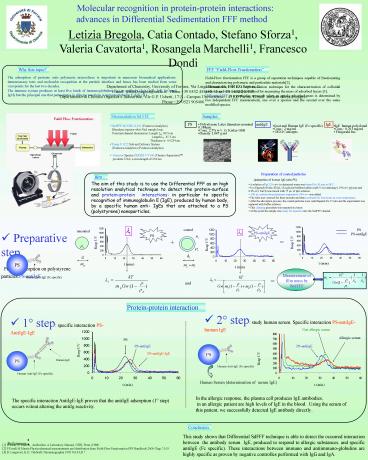Presentazione di PowerPoint PowerPoint PPT Presentation
1 / 1
Title: Presentazione di PowerPoint
1
Molecular recognition in
protein-protein interactions
advances in Differential Sedimentation FFF method
Letizia Bregola, Catia Contado, Stefano Sforza1,
Valeria Cavatorta1, Rosangela Marchelli1,
Francesco Dondi Department of Chemistry,
University of Ferrara, Via Luigi Borsari 46,
I-44100 Ferrara, I. E.mail letizia.bregola_at_unife.
it . Phone 39 0532 455155 Fax 39 0532
240709 1Dipartimento di Chimica Organica e
Industriale, V.le G.P. Usberti, 17/A - Campus
Universitario - 43100 Parma. E.mail
stefano.sforza_at_unipr.it. Phone 39 0521 905406
FFF Field-Flow Fractionation
Why this topic?
Field-Flow fractionation FFF is a group of
separation techniques capable of fractionating
and characterizing polymeric and particulate
materials2. Sedimentation FFF is a high
resolution technique for the characterization of
colloidal particles and it is a sensitive method
for measuring the mass of adsorbed layers
3. Differntial FFF is a particular approach
when an uptake adsorbed mass is determined by two
independent FFF measurement, one over a species
and the second over the same modified species.
The adsorption of proteins onto polymeric
microsferes is important in numerous biomedical
applications immunoassay tests and molecular
recognition at the particle interface and hence
has been studied from some viewpoints for the
last two decades. The immune system produces at
least five kinds of immunoglobulins (Ig) or
antibody (IgA, IgD, IgE, IgG and IgM) but the
principal one that partecipates in allergic
reactions is immunoglobulin E (IgE) 1
Samples
PS
antiIgE
IgE
- Polystyrene Latex diameters nominal 0.384µm.
- Conc. 2.5 w/v G. Kisker GbR
- Density 1.047 g/ml
- Goat anti Human IgE (Fc specific)
- Conc. 2 mg/ml
- OEM Comcepts
- IgE human polyclonal
- Conc. 0.761 mg/ml
- Fitzgerald Inc.
Preparation of coated particles
Aim
(adsorption of human IgG onto PS)
The aim of this study is to use the Differential
FFF as an high resolution analytical technique to
detect the protein-surface and protein-protein
interactions in particular to specific
recognition of immunoglobulin E (IgE), produced
by human body, by a specific human anti- IgEs
that are attached to a PS (polystyrene)
nanoparticles.
- A solution of IgG 2 w/v in deionized water was
heated for 30 min at 58C. - In a Eppendorf tube, 825µL of a glycine buffered
saline at pH 9.4 (containing 0.15 w/v glycine
and 0.2 w/v NaCl) was mixed with 75 µL of IgG
solution. - 100 µL portion the polystyrene suspension 10
w/v was added. - The tube was vortexed for three minutes and then
incubated for four hours at room temperature. - After the adsorption process, the coated
particles were centrifugated for 15 min and the
supernatant was replaced with buffer solution. - This cleaning procedure was repeated six times.
- At this point the sample was ready for injection
into the SedFFF channel.
PS
coated
uncoated
- Preparative step
- Protein adsorption on polystyrene
particlesPS-antiIgE
PS-antiIgE
Resp UV
d1
d
t (min)
Measurement of film mass by SedFFF
and
Protein-protein interaction
- 2 step study human serum. Specific interaction
PS-antiIgE-human IgE
- 1 step specific interaction PS-AntiIgE-IgE
Non allergic serum
Allergic serum
PS
PS-antiIgE
PS-antiIgE
Resp UV
PS-antiIgE-IgE
Resp UV
Human Serum (determination of serum IgE)
t (min)
t (min)
In the allergic response, the plasma cell
produces IgE antibodies, in an allergic patient
are high levels of IgE in the blood . Using the
serum of this patient, we successfully detected
IgE antibody directly.
The specific interaction AntiIgE-IgE proves that
the antiIgE adsorption (1 step) occurs witout
altering the antiIg reactivity.
Conclusion
References
This study shows that Differential SdFFF
technique is able to detect the occurred
interaction between the antibody serum IgE,
produced to respond to allergic substances, and
specific antiIgE (Fc specific). These
interactions between immuno and
antiimmuno-globulins are highly specific as
proven by negative controlles performed with IgG
and IgA.
1 D.Lane, E. Hallow, Antibodies A Laboratory
Manual, CSHL Press (1988) 2 F.Dondi M.Martin
Physicochemical measurements and distribution
from Field-Flow Fractionation FFF Handbook 2000
Chap.7,103 3 B. Langwost, K.D. Caldwell
Chromatographia 1992 Vol.34,317

